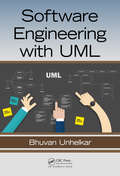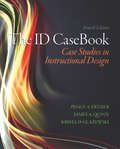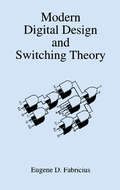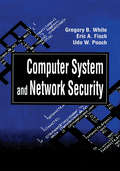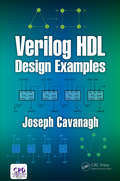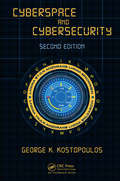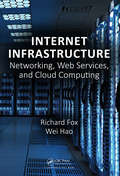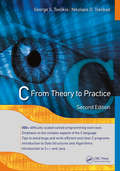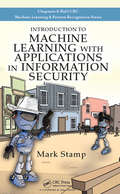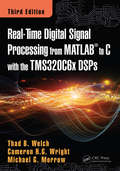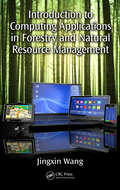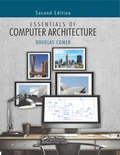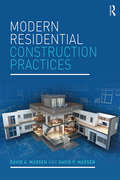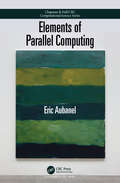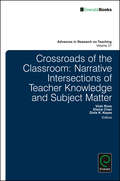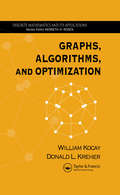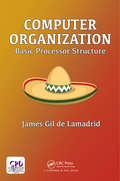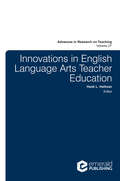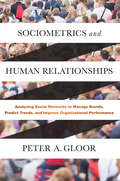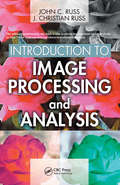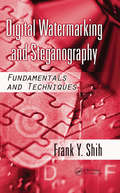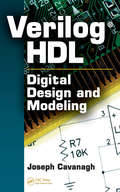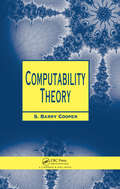- Table View
- List View
Digital Marketing: Integrating Strategy and Tactics with Values, A Guidebook for Executives, Managers, and Students
by Ira Kaufman Chris HortonDigital Marketing: Integrating Strategy and Tactics with Values is an easy-to-understand guidebook that draws on the latest digital tactics and strategic insights to help organizations generate sustainable growth through digital integration. It provides a roadmap to adopt a digital mindset, incorporate digital trends strategically, and integrate the most effective digital tactics and tools with core values to achieve competitive advantage. Bringing the reader through its five-step Path to Digital Integration (Mindset, Model, Strategy, Implementation, and Sustainability), Digital Marketing seeks to Outline the key drivers of change and leading digital marketing trends executives need to understand and incorporate to drive business opportunity. Evaluate the digital channels and technologies management teams can leverage to execute a successful Integrated Digital Marketing strategy. This includes insight into the latest digital tactics (website, social, mobile, search, content, and email marketing; data analytics) and social tools (Facebook, Twitter, YouTube, LinkedIn, Instagram, Pinterest, and Google Plus). Discover the impact of digital transformation on the organization, from the effect of digital tactics on the customer experience (CX) to the value of integrating internal digital strategies to facilitate collaboration and innovation. Guide aspiring leaders on how to combine core values and business goals with progressive digital strategies, tactics, and tools to generate sustainable outcomes for all stakeholders. This interactive guidebook provides a truly Connected Digital Experience (CDE): the Zappar augmented reality mobile app allows the reader to activate the "Discover More" and "Play Video" icons found throughout the book, instantly connecting the reader, via their mobile device, to additional content housed on our companion website, Digital Marketing Resource Center (www.dmresourcecenter.org). "Play Video" icons incorporate point-in-time video commenting solution Vusay to enable interactive social conversations around each video. Digital Marketing is the ideal guide for aspiring leaders – executives, instructors, owners, entrepreneurs, managers, students – at all stages of digital literacy. To request access to the resources in the Digital Marketing Resources Center, please contact Ira Kaufman at ira@entwinedigital.com.
Digital Marketing: Integrating Strategy and Tactics with Values, A Guidebook for Executives, Managers, and Students
by Ira Kaufman Chris HortonDigital Marketing: Integrating Strategy and Tactics with Values is an easy-to-understand guidebook that draws on the latest digital tactics and strategic insights to help organizations generate sustainable growth through digital integration. It provides a roadmap to adopt a digital mindset, incorporate digital trends strategically, and integrate the most effective digital tactics and tools with core values to achieve competitive advantage. Bringing the reader through its five-step Path to Digital Integration (Mindset, Model, Strategy, Implementation, and Sustainability), Digital Marketing seeks to Outline the key drivers of change and leading digital marketing trends executives need to understand and incorporate to drive business opportunity. Evaluate the digital channels and technologies management teams can leverage to execute a successful Integrated Digital Marketing strategy. This includes insight into the latest digital tactics (website, social, mobile, search, content, and email marketing; data analytics) and social tools (Facebook, Twitter, YouTube, LinkedIn, Instagram, Pinterest, and Google Plus). Discover the impact of digital transformation on the organization, from the effect of digital tactics on the customer experience (CX) to the value of integrating internal digital strategies to facilitate collaboration and innovation. Guide aspiring leaders on how to combine core values and business goals with progressive digital strategies, tactics, and tools to generate sustainable outcomes for all stakeholders. This interactive guidebook provides a truly Connected Digital Experience (CDE): the Zappar augmented reality mobile app allows the reader to activate the "Discover More" and "Play Video" icons found throughout the book, instantly connecting the reader, via their mobile device, to additional content housed on our companion website, Digital Marketing Resource Center (www.dmresourcecenter.org). "Play Video" icons incorporate point-in-time video commenting solution Vusay to enable interactive social conversations around each video. Digital Marketing is the ideal guide for aspiring leaders – executives, instructors, owners, entrepreneurs, managers, students – at all stages of digital literacy. To request access to the resources in the Digital Marketing Resources Center, please contact Ira Kaufman at ira@entwinedigital.com.
Software Engineering with UML
by Bhuvan UnhelkarThis book presents the analysis, design, documentation, and quality of software solutions based on the OMG UML v2.5. Notably it covers 14 different modelling constructs including use case diagrams, activity diagrams, business-level class diagrams, corresponding interaction diagrams and state machine diagrams. It presents the use of UML in creating a Model of the Problem Space (MOPS), Model of the Solution Space (MOSS) and Model of the Architectural Space (MOAS). The book touches important areas of contemporary software engineering ranging from how a software engineer needs to invariably work in an Agile development environment through to the techniques to model a Cloud-based solution.
The ID CaseBook: Case Studies in Instructional Design
by Peggy A. Ertmer James A. Quinn Krista D. GlazewskiFirst Published in 2017. Routledge is an imprint of Taylor & Francis, an Informa company.The Fourth Edition of this highly regarded problem-solving text presents 30 realistic case studies in a wide range of authentic contexts, from K-12 to post-secondary, corporate, and manufacturing. The cases and their accompanying discussion questions encourage ID students to analyze the available information, develop conclusions, and consider alternative possibilities in resolving ID problems.
Modern Digital Design and Switching Theory
by Eugene D. FabriciusModern Digital Design and Switching Theory is an important text that focuses on promoting an understanding of digital logic and the computer programs used in the minimization of logic expressions. Several computer approaches are explained at an elementary level, including the Quine-McCluskey method as applied to single and multiple output functions, the Shannon expansion approach to multilevel logic, the Directed Search Algorithm, and the method of Consensus. Chapters 9 and 10 offer an introduction to current research in field programmable devices and multilevel logic synthesis. Chapter 9 covers more advanced topics in programmed logic devices, including techniques for input decoding and Field-Programmable Gate Arrays (FPGAs). Chapter 10 includes a discussion of boolean division, kernels and factoring, boolean tree structures, rectangle covering, binary decision diagrams, and if-then-else operators. Computer algorithms covered in these two chapters include weak division, iterative weak division, and kernel extraction by tabular methods and by rectangle covering theory. Modern Digital Design and Switching Theory is an excellent textbook for electrical and computer engineering students, in addition to a worthwhile reference for professionals working with integrated circuits.
Computer System and Network Security (Computer Science & Engineering)
by Gregory B. White Eric A. Fisch Udo W. PoochComputer System and Network Security provides the reader with a basic understanding of the issues involved in the security of computer systems and networks. Introductory in nature, this important new book covers all aspects related to the growing field of computer security. Such complete coverage in a single text has previously been unavailable, and college professors and students, as well as professionals responsible for system security, will find this unique book a valuable source of information, either as a textbook or as a general reference. Computer System and Network Security discusses existing and potential threats to computer systems and networks and outlines the basic actions that are generally taken to protect them. The first two chapters of the text introduce the reader to the field of computer security, covering fundamental issues and objectives. The next several chapters describe security models, authentication issues, access control, intrusion detection, and damage control. Later chapters address network and database security and systems/networks connected to wide-area networks and internetworks. Other topics include firewalls, cryptography, malicious software, and security standards. The book includes case studies with information about incidents involving computer security, illustrating the problems and potential damage that can be caused when security fails.This unique reference/textbook covers all aspects of computer and network security, filling an obvious gap in the existing literature.
Verilog HDL Design Examples
by Joseph CavanaghThe Verilog language provides a means to model a digital system at many levels of abstraction from a logic gate to a complex digital system to a mainframe computer. The purpose of this book is to present the Verilog language together with a wide variety of examples, so that the reader can gain a firm foundation in the design of the digital system using Verilog HDL. The Verilog projects include the design module, the test bench module, and the outputs obtained from the simulator that illustrate the complete functional operation of the design. Where applicable, a detailed review of the theory of the topic is presented together with the logic design principles—including: state diagrams, Karnaugh maps, equations, and the logic diagram. Numerous examples and homework problems are included throughout. The examples include logical operations, counters of different moduli, half adders, full adders, a carry lookahead adder, array multipliers, different types of Moore and Mealy machines, and arithmetic logic units (ALUs).
Cyberspace and Cybersecurity
by George KostopoulosProviding comprehensive coverage of cyberspace and cybersecurity, this textbook not only focuses on technologies but also explores human factors and organizational perspectives and emphasizes why asset identification should be the cornerstone of any information security strategy. Topics include addressing vulnerabilities, building a secure enterprise, blocking intrusions, ethical and legal issues, and business continuity. Updates include topics such as cyber risks in mobile telephony, steganography, cybersecurity as an added value, ransomware defense, review of recent cyber laws, new types of cybercrime, plus new chapters on digital currencies and encryption key management.
Internet Infrastructure: Networking, Web Services, and Cloud Computing
by Richard Fox Wei HaoInternet Infrastructure: Networking, Web Services, and Cloud Computing provides a comprehensive introduction to networks and the Internet from several perspectives: the underlying media, the protocols, the hardware, the servers, and their uses. The material in the text is divided into concept chapters that are followed up with case study chapters that examine how to install, configure, and secure a server that offers the given service discussed. The book covers in detail the Bind DNS name server, the Apache web server, and the Squid proxy server. It also provides background on those servers by discussing DNS, DHCP, HTTP, HTTPS, digital certificates and encryption, web caches, and the variety of protocols that support web caching. Introductory networking content, as well as advanced Internet content, is also included in chapters on networks, LANs and WANs, TCP/IP, TCP/IP tools, cloud computing, and an examination of the Amazon Cloud Service. Online resources include supplementary content that is available via the textbook’s companion website, as well useful resources for faculty and students alike, including: a complete lab manual; power point notes, for installing, configuring, securing and experimenting with many of the servers discussed in the text; power point notes; animation tutorials to illustrate some of the concepts; two appendices; and complete input/output listings for the example Amazon cloud operations covered in the book.
C: From Theory to Practice, Second Edition
by George S. Tselikis Nikolaos D. TselikasThis easy-to-use, classroom-tested textbook covers the C programming language for computer science and IT students. Designed for a compulsory fundamental course, it presents the theory and principles of C. More than 500 exercises and examples of progressive difficulty aid students in understanding all the aspects and peculiarities of the C language. The exercises test students on various levels of programming and the examples enhance their concrete understanding of programming know-how. Instructor's manual and PowerPoint slides are available upon qualifying course adoption
Introduction to Machine Learning with Applications in Information Security
by Mark StampIntroduction to Machine Learning with Applications in Information Security provides a class-tested introduction to a wide variety of machine learning algorithms, reinforced through realistic applications. The book is accessible and doesn’t prove theorems, or otherwise dwell on mathematical theory. The goal is to present topics at an intuitive level, with just enough detail to clarify the underlying concepts. The book covers core machine learning topics in-depth, including Hidden Markov Models, Principal Component Analysis, Support Vector Machines, and Clustering. It also includes coverage of Nearest Neighbors, Neural Networks, Boosting and AdaBoost, Random Forests, Linear Discriminant Analysis, Vector Quantization, Naive Bayes, Regression Analysis, Conditional Random Fields, and Data Analysis. Most of the examples in the book are drawn from the field of information security, with many of the machine learning applications specifically focused on malware. The applications presented are designed to demystify machine learning techniques by providing straightforward scenarios. Many of the exercises in this book require some programming, and basic computing concepts are assumed in a few of the application sections. However, anyone with a modest amount of programming experience should have no trouble with this aspect of the book. Instructor resources, including PowerPoint slides, lecture videos, and other relevant material are provided on an accompanying website: http://www.cs.sjsu.edu/~stamp/ML/. For the reader’s benefit, the figures in the book are also available in electronic form, and in color. About the Author Mark Stamp has been a Professor of Computer Science at San Jose State University since 2002. Prior to that, he worked at the National Security Agency (NSA) for seven years, and a Silicon Valley startup company for two years. He received his Ph.D. from Texas Tech University in 1992. His love affair with machine learning began in the early 1990s, when he was working at the NSA, and continues today at SJSU, where he has supervised vast numbers of master’s student projects, most of which involve a combination of information security and machine learning.
Real-Time Digital Signal Processing from MATLAB to C with the TMS320C6x DSPs
by Cameron H.G. Wright Michael G. Morrow Thad B. WelchThis updated edition gives readers hands-on experience in real-time DSP using a practical, step-by-step framework that also incorporates demonstrations, exercises, and problems, coupled with brief overviews of applicable theory and MATLAB applications. Organized in three sections that cover enduring fundamentals and present practical projects and invaluable appendices, this new edition provides support for the most recent and powerful of the inexpensive DSP development boards currently available from Texas Instruments: the OMAP-L138 LCDK. It includes two new real-time DSP projects, as well as three new appendices: an introduction to the Code Generation tools available with MATLAB, a guide on how to turn the LCDK into a portable battery-operated device, and a comparison of the three DSP boards directly supported by this edition.
Introduction to Computing Applications in Forestry and Natural Resource Management
by Jingxin WangDue to the complexity of operational forestry problems, computing applications are becoming pervasive in all aspects of forest and natural resource management. This book provides a comprehensive introduction to computers and their applications in forest and natural resource management and is designed for both undergraduate and graduate students in forestry and natural resources. It introduces state-of-the-art applications for several of the most important computer technologies in terms of data acquisition, data manipulation, basic programming techniques, and other related computer and Internet concepts and applications. This book consists of six parts and 19 chapters.
Essentials of Computer Architecture
by Douglas ComerThis easy to read textbook provides an introduction to computer architecture, while focusing on the essential aspects of hardware that programmers need to know. The topics are explained from a programmer’s point of view, and the text emphasizes consequences for programmers. Divided in five parts, the book covers the basics of digital logic, gates, and data paths, as well as the three primary aspects of architecture: processors, memories, and I/O systems. The book also covers advanced topics of parallelism, pipelining, power and energy, and performance. A hands-on lab is also included. The second edition contains three new chapters as well as changes and updates throughout.
Modern Residential Construction Practices
by David A. Madsen David P. MadsenModern Residential Construction Practices provides easy-to-read, comprehensive and highly illustrated coverage of residential building construction practices that conform to industry standards in the United States and Canada. Each chapter provides complete descriptions, real-world practices, realistic examples, three-dimensional (3D) illustrations, and related tests and problems. Chapters cover practices related to every construction phase including: planning, funding, permitting, codes, inspections, site planning, excavation, foundations and flatwork, floors, walls, roofs, finish work and cabinetry; heating, ventilating, and air conditioning (HVAC); electrical, and plumbing. The book is organized in a format that is consistent with the process used to take residential construction projects from preliminary concept through all phases of residential building construction. An ideal textbook for secondary and college level construction programs, the book is packed with useful features such as problems that challenge students to identify materials and practices, along with research and document information about construction materials and practices, useful summaries, key notes, a detailed glossary, and online materials for both students and educators.
Elements of Parallel Computing (Chapman & Hall/CRC Computational Science)
by Eric AubanelDesigned for introductory parallel computing courses at the advanced undergraduate or beginning graduate level, Elements of Parallel Computing presents the fundamental concepts of parallel computing not from the point of view of hardware, but from a more abstract view of algorithmic and implementation patterns. The aim is to facilitate the teaching of parallel programming by surveying some key algorithmic structures and programming models, together with an abstract representation of the underlying hardware. The presentation is friendly and informal. The content of the book is language neutral, using pseudocode that represents common programming language models. The first five chapters present core concepts in parallel computing. SIMD, shared memory, and distributed memory machine models are covered, along with a brief discussion of what their execution models look like. The book also discusses decomposition as a fundamental activity in parallel algorithmic design, starting with a naive example, and continuing with a discussion of some key algorithmic structures. Important programming models are presented in depth, as well as important concepts of performance analysis, including work-depth analysis of task graphs, communication analysis of distributed memory algorithms, key performance metrics, and a discussion of barriers to obtaining good performance. The second part of the book presents three case studies that reinforce the concepts of the earlier chapters. One feature of these chapters is to contrast different solutions to the same problem, using select problems that aren't discussed frequently in parallel computing textbooks. They include the Single Source Shortest Path Problem, the Eikonal equation, and a classical computational geometry problem: computation of the two-dimensional convex hull. After presenting the problem and sequential algorithms, each chapter first discusses the sources of parallelism then surveys parallel algorithms.
Crossroads of the Classroom: Narrative Intersections of Teacher Knowledge and Subject Matter (Advances in Research on Teaching #28)
by Vicki Ross Elaine Chan Dixie K. KeyesThis book aims to explore and make visible the intersection of subject matter knowledge and teacher knowledge in the narratives of teachers. This complicated interaction between these two bodies of knowledge is often studied and little understood. This book uses narrative to examine the complexities of teaching and learning. The authors of the chapters, as well as the editors, use innovative approaches to narrative methodology for research on teaching and teacher education in areas of education critical to teachers’ lives. Particularly through this book, they continue to advance the work of researchers to display narratives of educator lives and ways of knowing while opening the space for a community of narrative scholars.
Graphs, Algorithms, and Optimization (Discrete Mathematics and Its Applications)
by William Kocay Donald L. KreherGraph theory offers a rich source of problems and techniques for programming and data structure development, as well as for understanding computing theory, including NP-Completeness and polynomial reduction. A comprehensive text, Graphs, Algorithms, and Optimization features clear exposition on modern algorithmic graph theory presented in a rigorous yet approachable way. The book covers major areas of graph theory including discrete optimization and its connection to graph algorithms. The authors explore surface topology from an intuitive point of view and include detailed discussions on linear programming that emphasize graph theory problems useful in mathematics and computer science. Many algorithms are provided along with the data structure needed to program the algorithms efficiently. The book also provides coverage on algorithm complexity and efficiency, NP-completeness, linear optimization, and linear programming and its relationship to graph algorithms.Written in an accessible and informal style, this work covers nearly all areas of graph theory. Graphs, Algorithms, and Optimization provides a modern discussion of graph theory applicable to mathematics, computer science, and crossover applications.
Computer Organization: Basic Processor Structure
by James Gil de LamadridComputer Organization: Basic Processor Structure is a class-tested textbook, based on the author’s decades of teaching the topic to undergraduate and beginning graduate students. The main questions the book tries to answer are: how is a processor structured, and how does the processor function, in a general-purpose computer? The book begins with a discussion of the interaction between hardware and software, and takes the reader through the process of getting a program to run. It starts with creating the software, compiling and assembling the software, loading it into memory, and running it. It then briefly explains how executing instructions results in operations in digit circuitry. The book next presents the mathematical basics required in the rest of the book, particularly, Boolean algebra, and the binary number system. The basics of digital circuitry are discussed next, including the basics of combinatorial circuits and sequential circuits. The bus communication architecture, used in many computer systems, is also explored, along with a brief discussion on interfacing with peripheral devices. The first part of the book finishes with an overview of the RTL level of circuitry, along with a detailed discussion of machine language. The second half of the book covers how to design a processor, and a relatively simple register-implicit machine is designed. ALSU design and computer arithmetic are discussed next, and the final two chapters discuss micro-controlled processors and a few advanced topics.
Innovations in English Language Arts Teacher Education (Advances in Research on Teaching #27)
by Stefinee E. Pinnegar Heidi L. HallmanChanges in the discipline of english language arts teacher education have produced a much more expansive understanding of literacy and of what teachers of English language arts do. This volume addresses these changes by featuring innovation—both theoretical and applied—in the field itself. Changes in the field of English language arts teacher education suggest a need to also examine how teachers approach learning to teach in a field that has so quickly evolved. This book seeks to understand how a future teaching force will approach this changing landscape and how we, as English teacher educators, might effectively prepare them to do so.
Sociometrics and Human Relationships: Analyzing Social Networks to Manage Brands, Predict Trends, and Improve Organizational Performance
by Peter A. GloorSociometrics and Human Relationships translates the latest academic research into practical business strategies and techniques as well as actionable insights, providing a wealth of examples for social network analysis and predicting trends. Gloor illustrates how to improve organizational performance by optimizing communication and collaboration through email. Based on Collaborative Innovation Networks courses which have been taught for over a decade to students forming virtual teams across a number of universities, Gloor shows readers how to leverage virtual collaborative creativity in the Internet age, and helps them understand and apply the dynamics of online communication via a variety of tools. Gloor has also created a tool that analyses all types of social media such as: Twitter, Wikipedia, online blogs and Facebook as well as email or Skype logs to predict election outcomes, perception and strength of brands, customer and employment satisfaction, or fraudulent behavior. Gloor explains how to use his tool, Condor, to visualize, monitor and manage brands, products and topics online, as well as analyzing organizations through their email networks.
Introduction to Image Processing and Analysis
by John C. Russ J. Christian RussImage processing comprises a broad variety of methods that operate on images to produce another image. A unique textbook, Introduction to Image Processing and Analysis establishes the programming involved in image processing and analysis by utilizing skills in C compiler and both Windows and MacOS programming environments. The provided mathematical background illustrates the workings of algorithms and emphasizes the practical reasons for using certain methods, their effects on images, and their appropriate applications. The text concentrates on image processing and measurement and details the implementation of many of the most widely used and most important image processing and analysis algorithms. Homework problems are included in every chapter with solutions available for download from the CRC Press website The chapters work together to combine image processing with image analysis. The book begins with an explanation of familiar pixel array and goes on to describe the use of frequency space. Chapters 1 and 2 deal with the algorithms used in processing steps that are usually accomplished by a combination of measurement and processing operations, as described in chapters 3 and 4. The authors present each concept using a mixture of three mutually supportive tools: a description of the procedure with example images, the relevant mathematical equations behind each concept, and the simple source code (in C), which illustrates basic operations. In particularly, the source code provides a starting point to develop further modifications.Written by John Russ, author of esteemed Image Processing Handbook now in its fifth edition, this book demonstrates functions to improve an image's of features and detail visibility, improve images for printing or transmission, and facilitate subsequent analysis.
Digital Watermarking and Steganography: Fundamentals and Techniques
by Frank Y. ShihEvery day millions of people capture, store, transmit, and manipulate digital data. Unfortunately free access digital multimedia communication also provides virtually unprecedented opportunities to pirate copyrighted material. Providing the theoretical background needed to develop and implement advanced techniques and algorithms, Digital Watermarking and Steganography: Demonstrates how to develop and implement methods to guarantee the authenticity of digital media Explains the categorization of digital watermarking techniques based on characteristics as well as applications Presents cutting-edge techniques such as the GA-based breaking algorithm on the frequency-domain steganalytic system The popularity of digital media continues to soar. The theoretical foundation presented within this valuable reference will facilitate the creation on new techniques and algorithms to combat present and potential threats against information security.
Verilog HDL: Digital Design and Modeling
by Joseph CavanaghEmphasizing the detailed design of various Verilog projects, Verilog HDL: Digital Design and Modeling offers students a firm foundation on the subject matter. The textbook presents the complete Verilog language by describing different modeling constructs supported by Verilog and by providing numerous design examples and problems in each chapter. Examples include counters of different moduli, half adders, full adders, a carry lookahead adder, array multipliers, different types of Moore and Mealy machines, and much more. The text also contains information on synchronous and asynchronous sequential machines, including pulse-mode asynchronous sequential machines.In addition, it provides descriptions of the design module, the test bench module, the outputs obtained from the simulator, and the waveforms obtained from the simulator illustrating the complete functional operation of the design. Where applicable, a detailed review of the topic's theory is presented together with logic design principles, including state diagrams, Karnaugh maps, equations, and the logic diagram. Verilog HDL: Digital Design and Modeling is a comprehensive, self-contained, and inclusive textbook that carries all designs through to completion, preparing students to thoroughly understand this popular hardware description language.
Computability Theory (Chapman Hall/CRC Mathematics Series)
by S. Barry CooperComputability theory originated with the seminal work of Gödel, Church, Turing, Kleene and Post in the 1930s. This theory includes a wide spectrum of topics, such as the theory of reducibilities and their degree structures, computably enumerable sets and their automorphisms, and subrecursive hierarchy classifications. Recent work in computability theory has focused on Turing definability and promises to have far-reaching mathematical, scientific, and philosophical consequences. Written by a leading researcher, Computability Theory provides a concise, comprehensive, and authoritative introduction to contemporary computability theory, techniques, and results. The basic concepts and techniques of computability theory are placed in their historical, philosophical and logical context. This presentation is characterized by an unusual breadth of coverage and the inclusion of advanced topics not to be found elsewhere in the literature at this level.The book includes both the standard material for a first course in computability and more advanced looks at degree structures, forcing, priority methods, and determinacy. The final chapter explores a variety of computability applications to mathematics and science.Computability Theory is an invaluable text, reference, and guide to the direction of current research in the field. Nowhere else will you find the techniques and results of this beautiful and basic subject brought alive in such an approachable and lively way.


